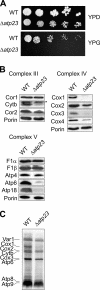Prohibitins interact genetically with Atp23, a novel processing peptidase and chaperone for the F1Fo-ATP synthase
- PMID: 17135288
- PMCID: PMC1783772
- DOI: 10.1091/mbc.e06-09-0839
Prohibitins interact genetically with Atp23, a novel processing peptidase and chaperone for the F1Fo-ATP synthase
Abstract
The generation of cellular energy depends on the coordinated assembly of nuclear and mitochondrial-encoded proteins into multisubunit respiratory chain complexes in the inner membrane of mitochondria. Here, we describe the identification of a conserved metallopeptidase present in the intermembrane space, termed Atp23, which exerts dual activities during the biogenesis of the F(1)F(O)-ATP synthase. On one hand, Atp23 serves as a processing peptidase and mediates the maturation of the mitochondrial-encoded F(O)-subunit Atp6 after its insertion into the inner membrane. On the other hand and independent of its proteolytic activity, Atp23 promotes the association of mature Atp6 with Atp9 oligomers. This assembly step is thus under the control of two substrate-specific chaperones, Atp10 and Atp23, which act on opposite sides of the inner membrane. Strikingly, both ATP10 and ATP23 were found to genetically interact with prohibitins, which build up large, ring-like assemblies with a proposed scaffolding function in the inner membrane. Our results therefore characterize not only a novel processing peptidase with chaperone activity in the mitochondrial intermembrane space but also link the function of prohibitins to the F(1)F(O)-ATP synthase complex.
Figures







References
-
- Ackerman S. H., Tzagoloff A. Function, structure, and biogenesis of mitochondrial ATP synthase. Prog. Nucleic Acid Res. Mol. Biol. 2005;80:95–133. - PubMed
-
- Ackermann S. H., Tzagoloff A. ATP10, a yeast nuclear gene required for the assembly of the mitochondrial F1-F0 complex. J. Biol. Chem. 1990;265:9952–9959. - PubMed
Publication types
MeSH terms
Substances
LinkOut - more resources
Full Text Sources
Molecular Biology Databases

